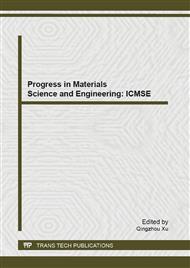p.415
p.423
p.427
p.432
p.437
p.443
p.448
p.457
p.465
Improvement of Adsorption Performance Based on Metal Ion Modified ETS-4 Molecular Sieves
Abstract:
Titanosilicate ETS-4 with the Sr and Ni cations modification were prepared by hydrotherrmal method using titanium trichloride and tetraethoxysilane as raw materials. The properties and morphology of the materials were characterized by XRD, SEM techniques, Sr and Ni introduced to the molecular sieve affected the frame contraction when they were heated, and did little effect on the crystallization and morphology. N2 and CH4 isotherms of each sample were measured at room temperature. The Sr and Ni doping could improve the N2 and CH4 adsorption capacities of ETS-4. The capacities of the two gases increased in the pressurization process for ETS-4-Sr and ETS-4-Ni, with the pressure increasing, no significant change in capacities of N2 and CH4 was observed over the ETS-4 sample. Compared to ETS-4 molecular sieves, the capacity for N2 of ETS-4-Sr and ETS-4-Ni at the pressure of 1200 mmHg increased 4.2 and 3.9 times, respectively. At last, the results indicated that the cations doping (Sr2+ and Ni2+) can improve the adsorption performance of ETS-4 greatly.
Info:
Periodical:
Pages:
437-442
Citation:
Online since:
October 2013
Authors:
Keywords:
Price:
Сopyright:
© 2013 Trans Tech Publications Ltd. All Rights Reserved
Share:
Citation:


